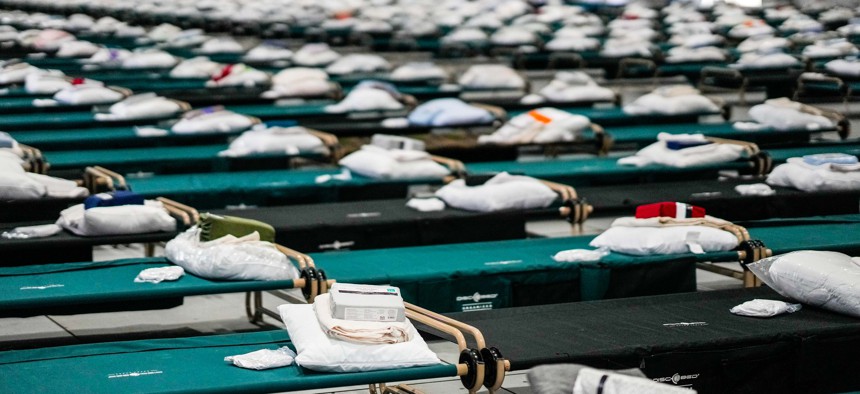Policy
New York City is desperate to find more space to house asylum seekers
Mayor Adams issued an executive order suspending the land use review process to create more shelters quickly, prompting criticism from the City Council.

New York City has started using public school gyms as emergency shelters for migrants and is now looking to public libraries as potential spaces to house migrants. Michael Appleton/Mayoral Photography Office
Mayor Eric Adams’ administration is casting itself as increasingly desperate as it looks to prepare for an expected influx of asylum-seekers to New York City.
The administration has predicted that many more migrants from the southern border will arrive in New York City following last week’s expiration of Title 42, a federal order that allowed immigration authorities to turn more people away at the border due to the pandemic. In recent weeks, the Adams administration said, the city has seen more than 500 new arrivals on some days, and they expect those numbers to grow with the end of Title 42, though it’s still unclear exactly what impact the end of the federal order will have.
City Hall is already preparing for a scenario that sees lots of new arrivals. The city has started using public school gyms as emergency shelters for migrants and is now looking to public libraries as potential spaces to house migrants. The city has also attempted to get other localities to help shelter asylum-seekers, though such attempts have been met with a wall of resistance from upstate and suburban county executives.
On Monday, as Gothamist first reported, the mayor signed an emergency executive order that will allow the administration to circumvent the city’s extensive land use review process to locate and build new homeless shelters in light of the “unprecedented humanitarian crisis.” The emergency executive order, which temporarily suspends the land use review rules for homeless shelters, builds on an order from October 2022, which suspended the city’s Uniform Land Use Review Process for building and siting emergency relief centers. Last week, the Adams administration issued another executive order suspending some aspects of the city’s “right to shelter,” including the requirement that families promptly be placed in private rooms with a bathroom, refrigerator and cooking facilities.
“With 150 emergency sites opened, including eight humanitarian relief centers, we have reached our limit, and had to resort to temporarily placing recent arrivals in gyms and other temporary locations,” City Hall spokesperson Fabien Levy said in an emailed statement on Tuesday. “In an effort to mitigate those risks and find room within our shelter system, the city has extended the temporary suspension of the policy surrounding timing for placements in shelters, as well as extended the suspension of certain ULURP rules to further expedite the siting, construction, and operation of additional facilities, thereby speeding up the process of bringing needed shelter space online. This is not a decision taken lightly and we will make every effort to get asylum seekers into shelter as quickly as possible as we have done since day one.” Levy did not comment on exactly what kind of facilities or shelter conversions this order will allow the administration to fast-track but said they are open to all ideas.
The City Council, which has a prominent role in land use through ULURP, criticized the administration’s use of executive orders, though it did not comment specifically on the suspension of the review process. “The overuse of executive orders, with over 400 Emergency Executive Orders in the less than year-and-a-half of this administration, is concerning and raises questions,” a Council spokesperson wrote in an email. “The way these orders have been rolled out, without communication to the Council and other stakeholders, is also problematic.”
Levy pointed to the work the administration’s done over the past year to manage the influx of asylum-seekers, and said it’s easy for others to criticize. “For more than a year, this administration has, largely on its own, fed, clothed and sheltered more than 65,000 asylum-seekers. We've been asking for support for the better part of a year, yet received no ideas from many of our loudest city, state and federal leaders criticizing us,” Levy said. “No one has come to us with a long term plan, just with complaints about where shelters should be placed. It's easy to complain, it's hard to roll up your sleeves and get stuff done.”
The Legal Aid Society, which has advocated for strict adherence to the city’s right to shelter mandate and the sheltering of all asylum-seekers, applauded the administration’s move to suspend the ULURP process. “There’s a very urgent situation, we have large numbers of migrants coming into the city, and Mayor Adams’ administration is doing everything it can to accommodate thousands of people over a very short period of time,” said Edward Josephson, a supervisor at the Legal Aid Society’s Civil Law Reform Unit. “This can only help. It seems like they may need to rehabilitate facilities and make them available for families or for singles. And if there are some technical conflicts with the zoning resolution, that could tie something up in ULURP for months and months. So it seems like this is a necessary step.”
Still, the move to circumvent land use review processes for homeless shelters – which other residents and property owners routinely oppose – could trigger backlash or even legal challenges, one attorney warned. “I would imagine they will be able to make some siting decisions very quickly in the immediate term, but there is a substantial potential for lawsuits,” said James Power, a partner at Kramer Levin who focuses on real estate and land use issues. “Particularly since homeless shelter siting is one of the most contentious types of land use procedures in New York City, and sometimes does result in lawsuits.”

